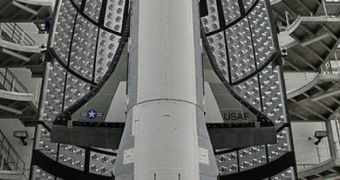Some United States Air Force (USAF) officials recently made announcements that led experts to believe that the experimental spy spacecraft that was launched in orbit on April 22 is nearing its mission's end.
In the mean time, the unmanned spy plane continues to maneuver in Earth's orbit, changing course and conducting classified activities. Amateur skywatchers and astronomers are keeping track of its activity.
The X-37B space plane is also known as the Orbital Test Vehicle 1, and it was developed by the Boeing Company. The project first spent a few years at NASA, before being taken over by the US Defense Advanced Research Projects Agency (DARPA).
The completed space plane launched earlier this year from the Cape Canaveral Air Force Station (CCAFS), in Florida, aboard an Atlas V delivery system. It has remained in orbit ever since.
Officially, the information released by the USAF on the X-37 are more than scarce. Authorities are not saying a word about which orbit the spacecraft is on, the payload it carries, or when the robot is due to return to Earth.
“Nothing new. The first flight of the X-37B/OTV-1 is ongoing and continues to focus on checking out the on-orbit performance of the vehicle and proving the technologies required for long-duration, re-usable space vehicles with autonomous re-entry and landing capabilities,” says Tracy Bunko.
Once the mission is completed, “we look forward to a successful re-entry and recovery at Vandenberg Air Force Base, California,” Bunko, a spokeswoman at the Pentagon's USAF press desk tells Space.
According to astronomers who are tracking the spacecraft every movement, it would appear that the orbit the X-37 is currently using takes it on correct courses for several landing opportunities per day.
This means that the spy plane will not have to make any sort of additional orbital maneuvers when its controllers decide to bring it home.
“It has made four significant maneuvers, including the latest one. All of its previous orbits resulted in ground tracks that nearly repeated after two, three, four or six days,” says Ted Molczan, a veteran skywatcher that has been tracking the USAF robot.
“Ground tracks that nearly repeat after two, three or four days have long been a feature of US imaging reconnaissance satellites, which leads me to suspect that X-37B is carrying experimental sensors for that purpose,” he goes on to say.
“The mission is demonstrating one of the primary uses planned for the X-37B: flying attached sensor payloads so that their performance can be assessed before they are integrated with much more costly free-flying systems,” adds Craig Covault.
He is a veteran space reporter, and he made the statements in a paper published in the November issue of the American Institute of Aeronautics and Astronautics magazine Aerospace America.

 14 DAY TRIAL //
14 DAY TRIAL //